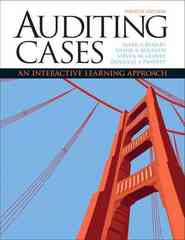Auto Parts, Inc. ('the Company) manufactures automobile subassemblies marketed primarily to the big three U.S. automakers. The
Question:
Auto Parts, Inc. (‘'the Company”) manufactures automobile subassemblies marketed primarily to the “big three” U.S. automakers. The publicly held Company«’s unaudited financial statements for the year ended December 31, 2008, reflect total assets of \($56\) million, total revenues of approximately \($73\) million, and pre-tax income of \($6\) million. The Company’s audited financial statements for the year ended December 31, 2007, reflected total assets of \($47\) million, total revenues of approximately \($60\) million, and pre-tax income of \($5\) million. Earnings per share have increased steadily over the past five years, with a cumulative return of 140% over that period.
During 2008, the Company significantly expanded its plant and fixed asset spending to accommodate increased orders received by its brake valve division. The company also accumulated significant levels of tooling supplies, which primarily consist of drill bits and machine parts utilized in the manufacturing process. The nature of the tooling supplies is such that the parts wear out relatively quickly and require continual replacement.
In prior years, the Company expensed tooling supplies as they were purchased. However, at the beginning of2008 the controller and chief financial officer (CFO) determined that capitalization of the tooling supplies would be the preferable method of accounting. The Company changed its accounting policy accordingly and began to include the tooling supplies in “other current assets” until the supplies are placed into service, at which time the Company enters a journal entry to remove the assets and record the costs of the used supplies as an expense.
During the prior year, 2007, the Company incurred roughly \($650\),000 of tooling expense and held approximately \($35\),000 of the tooling supplies on hand at year-end. The on-hand supplies were not included in assets on Auto Parts’ balance sheet at December 31, 2007. The amount of supplies on hand at December 31, 2006 was trivial. In 2008 the Company purchased \($1\),330,000 of tooling supplies, of which the company used \($1\),000,000 during the year (in addition to the approximately \($35\),000 on hand at the beginning of the year). The increase of tooling supplies at year-end reflects the company’s belief that prices would rise on the supplies in the first or second quarter of 2009. As such, the unaudited financial statements for the year ended December 31, 2008 reflect \($1\),000,000 of tooling expense on the income statement and \($330\),000 of tooling supplies as current assets on the balance sheet. The approximately \($35\),000 of tooling supplies on-hand at the end of last year were not included in the \($1\),000,000 tooling expense recorded in 2008 because those costs were expensed in 2007 under the old accounting policy.
Because your accounting firm serves as external auditor for Auto Parts, the CFO and the controller asked your firm for advice on whether the Company would be required to account for and disclose the accounting policy change as a change in accounting principle, a change in estimate or an error correction. In the client’s opinion, the change is not material to. the financial statements and, therefore, would not require disclosure in the 2008 financial statements. The client strongly prefers to not make any disclosure related to the policy change, as such the 2007 comparative statements would not be adjusted and the 2008 statements would simply reflect the new policy (i.e., decrease in expense and increase in other current assets) without the added attention of a disclosure.
REQUIRED
[1] Describe whether you agree that capitalization of the tooling supplies is the preferable method of accounting for Auto Parts, Inc.
[2] Assuming the policy change is considered material, how should it be reported and disclosed in the 2008 financial statements and what effect, if any, would the accounting change have on the auditor’s report?
[3] In general, how do auditors develop an estimate of financial statement materiality? For Auto Parts, Inc., what is your estimate of financial statement materiality? Are there qualitative factors that might impact your decision about the materiality of the accounting treatment and the related disclosure?
[4] Do you concur with management’s assessment that the accounting change is immaterial and, therefore, requires no disclosure? Why or why not?
Step by Step Answer:

Auditing Cases An Interactive Learning Approach
ISBN: 978-0132423502
4th Edition
Authors: Steven M Glover, Douglas F Prawitt





